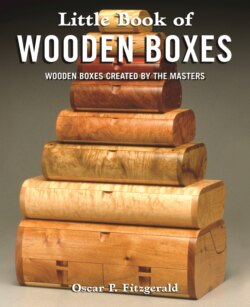Читать книгу Little Book of Wooden Boxes - Oscar Penn Fitzgerald - Страница 16
Into the 20th Century
ОглавлениеBy the twentieth century, handmade boxes fell out of favor as large factories met the demand for containers. Food was now stored in glass bottles, plastic jars, or cardboard boxes. If we want to store something, it is usually in a cardboard box or a plastic container. We write at desk computers or laptops, not elegant wooden lap desks.
As bathrooms became an essential component of twentieth century homes, dressing boxes largely disappeared as most men and women stored their body care products in wall cabinets or on the sink counter.
With the exception of decorative boxes for special uses, most modern boxes are made of solid or woven plastic, cardboard, or tin, and are designed for specific utilitarian purposes. Document boxes still exist, but they take the form of plastic boxes, metal-filing cases, or simple cardboard boxes with no tops. Plastic organizers provide specialized compartments for the detritus that clutters the modern desk.
In some quarters, jewelry boxes have morphed into something entirely unexpected. When compact discs became popular in the early 1980s, the Polygram record division of Philips Electric designed a thin, plastic box to hold them based loosely on the familiar plastic audiocassette box developed in the 1960s. They soon became known as jewel cases, not because they held anything rare—in 1990 alone, nearly 300 million were made—but because the hinge on the case worked like the arbors in watches that spin on tiny jewels.
The box-making tradition survives today, if largely as an art form. Since World War II and the resurgence of handcraftsmanship, the interest in fine boxes has grown. In the eighteenth and nineteenth centuries many boxes were turned out of both wood and metal, but by and large they were utilitarian and plain. Today, however, turning has evolved into a high art, and turned boxes are among the most creative containers. The tradition of fine wooden boxes as luxury items was not revived until the second half of the twentieth century.
Most traditional turned boxes took the form of simple cylinders. Lids were added to vase-shaped vessels. It was an easy leap to add a turned top to a turned vase-shaped vessel, making it into a box. Common in the nineteenth century, these turned boxes were more ornamental than useful, but they were still boxes.
Over the centuries, the box has evolved into many specialized forms to hold every conceivable object. Today, objects and their containers overwhelm us and we even rent off-site storage in which to hold them. However, the handcrafted boxes in this book are in another category. They are the result of countless hours of highly skilled labor, creative talent, and imagination. In the process, the makers have left their unique fingerprints and a bit of their soul in their boxes.
These artists speak with their hands and we are inspired to listen.
